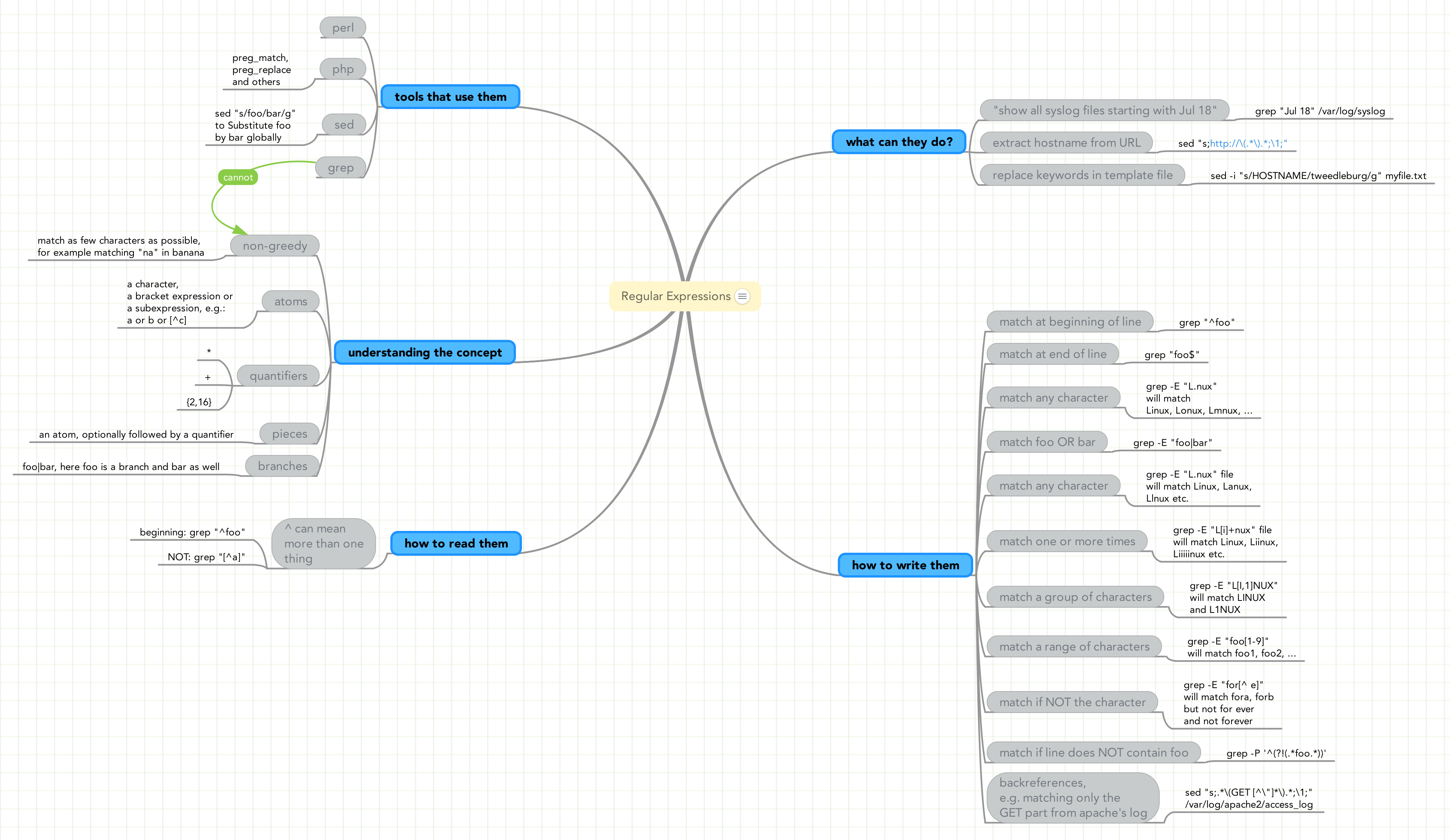Regular expressions
Regular expressions allow you to formulate string patterns to search or replace. For example, to show all lines that begin with the string Sep 13 in a file myfile.txt issue:
grep -E "^Sep 13" myfile.txt
In this case ^Sep 13 is your regular expression. You used it to search for a string. And there is much more you can do with regular expressions.
 |
RegEx cheat sheet |
Contents
Escaping
The characters ^ and \ are seen as control-characters. ^ means "at the beginning of a line". With a backslash, you can escape these control-characters, meaning they act as body-characters again:
grep "^hallo" file
finds all occurrences of "hallo" at the beginning of a line in file.
grep "\^hallo"
finds all occurrences of "^hallo" in a file
grep "\\^hallo"
finds all occurrences of "\^hallo" in a file
grep "\\\\^hallo"
finds all occurrences of "\\^hallo" in a file And so on...
Write regular expressions
For "finding a pattern defined by a regular expression", we speak of "matching".
Beginning of a line is
grep "^hallo" file
prints all occurrences of "hallo" at the beginning of a line in file.
The end of a line
grep "hallo$" file
prints all occurrences of "hallo" at the end of a line in file.
Find string1 OR string2
grep -E "Sep|Aug" file
prints all lines from file that contain "Sep" or "Aug".
Match a group of characters
grep -E "L[I,1]NUX" file
prints all lines from file that contain "LINUX" or "L1NUX"
Match a range of characters
grep -E "foo[1-9]" file
prints all lines from file that contain "foo1" or "foo2" till "foo9"
NOT the following characters
To invert matching for a group of characters
grep -E "for[^ e]" file
prints all lines from file that contain "for", but not followed by a space or an e, so not "for you" or "foresee"
With grep you have an additional possibility to invert matches:
grep -Ev "gettimeofday" file
prints all lines from file that do NOT contain "gettimeofday". This is a grep feature.
Any character
grep -E "L.nux" file
matches any character that is not a newline, e.g. Linux, Lenux and L7nux in file.
Match one or more times
grep -E "L[i]+nux" file
Match if i is there at least once in file The + here is a quantifier. It means, that i occurs 1 or more times. It is also possible to accept 0 or more times if you replace the + by a *.
Match n times
/etc/services is a table for protocols (services) and their port numbers. The protocols are filled up with blanks to have 16 characters. If you want to replace all protocols for port 3200 with sapdp00 you do it like this:
sed -ri "s/.{16}3200/sapdp00 3200/" /etc/services
Backreferences
Backreferences allows you to reuse matches. For example consider the following line from /var/log/apache2/access_log:
84.163.99.149 - - [21/Jan/2012:15:23:40 +0100] "GET /wiki/Special:RecentChanges HTTP/1.1" 200 66493 "http://www.linuxintro.org/index.php?title=Configuring_and_securing_sshd&action=history" "Mozilla/5.0 (X11; Linux x86_64; rv:9.0.1) Gecko/20100101 Firefox/9.0.1"
If you want to "extract the string containing GET between the quotes" you best use backreferences like this:
cat /var/log/apache2/access_log | sed "s;.*\(GET [^\"]*\).*;\1;"
Read regular expressions
*
An asterisk is a quantifier saying "whatever number of".
grep -E "Li*nux" file Lnux Linux Liinux Liiinux
An asterisk is placed next to an atom that can be repeated in whatever number. In the above example, the atom is the i character, but it can also be a group of characters:
grep -E "ba(na)*" file ba bana banana bananana
^
The ^ character stands for
- the beginning of a line if it stands at the beginning of a branch
# grep ^foo barfoo foo foo
- "not" if it stands behind a bracket
# grep for[^e] foresee for each for each
- the ^ character if it is escaped
# grep "\^" adsf as^df as^df
Understand regular expressions
Branches, Pieces and Atoms
A regular expression consists of one or more branches, separated by "|", the "OR" sign. If one of the branches matches, the expression matches:
grep -E "Tom|Harry"
Here, the expression is Tom|Harry, and Tom and Harry are both branches.
A branch consists of one or more pieces, seen in its particular order. A piece is an atom optionally followed by a quantifier:
grep -E "To*m"
Here, T is a piece as well as o* and m.
An atom is a character, a bracket expression or a subexpression. Each line can be an atom:
a b [^e] (this is a subexpression)
quantifiers
A quantifier is used to define that an atom can exist several times. The * quantifier defines the atom in front of it can occur 0, 1 or several times:
grep -E "To*m"
Will find all lines containing Tom, Toom, Tooom and Tm.